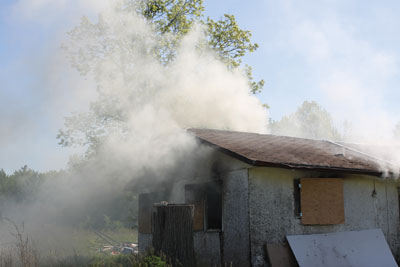
Features
Structural
Training
Tim-Bits: October 2012
One key fire-ground operation that is frequently glossed over and practised incorrectly or inaccurately in training programs is horizontal ventilation
September 26, 2012
By Tim Llewellyn
One key fire-ground operation that is frequently glossed over and practised incorrectly or inaccurately in training programs is horizontal ventilation, specifically ventilation by interior search or attack crews as they move throughout the structure. As a student of the fire service, I often hear that the need for fire buildings to be opened up early is of paramount importance. I cannot dispute that statement – but, what is not emphasized strongly enough is that opening up the structure needs to be done with a bit of thought, planning and communication.
 |
|
| Horizontal ventilation on the windward side of the building should be avoided; even mild winds can cause extreme fire propagation throughout the structure. Photo by Mark van der Feyst
|
Here’s the scenario: you are part of a primary search crew performing an oriented right-hand search of a bedroom in a single-storey residential structure with a fire in the kitchen area. Your officer is at the door of a room with the thermal-imaging camera. The smoke is thick, with visibility of about 15 centimetres. You can hear the engine crew over the radio calling for more hose. The heat level is moderate – not too hot, but not someplace you’d like to stay for long. As you turn the second corner, your right hand sweeps curtains and blinds. You recognize this as a window and your first instinct is to get this window open to let some of this heat and smoke out and improve visibility. But wait! Before you break open that window, a few things have to be considered. Let’s get into this a little more.
Interior crew members cannot indiscriminately break out windows or open exterior doors as they go. Crew members first need to determine whether they are venting for fire or for life. Venting for fire means opening up windows to make conditions easier for the hose team members when they open their nozzles on the fire; the steam they create will have somewhere to go other than back on top of them. Venting for life means replacing bad air with good air to give potential fire victims a greater chance of survival and to allow search crews to do their jobs under less threatening conditions. Here are a few of the questions that need to be answered before opening that window:
What is the prevailing wind direction and condition?
On windy days, if the fire and the wind are on the same side of the building, horizontal ventilation openings made on the windward side of the structure should be avoided. Even mild to moderate prevailing winds can cause extreme fire propagation downwind throughout the structure.
This phenomenon is not just seen in highrise fire fighting. There are many documented cases of wind-driven fires in single-storey residential dwellings that have resulted in firefighter injuries and fatalities. All interior crews must make note of the wind conditions before entering the structure and avoid making openings on the windward side.
Is the hose team in place for fire attack?
If windows or doors are opened before the hose team is ready, the constant inrush of fresh air can and will cause the fire to grow and extend.
If the outside venting firefighter breaks open the window to the fire room before the hose team has stretched its line, the fire can grow and auto-expose on the outside of the building and into upper floors or the attic space. The hose team and the ventilation team must communicate with each other when venting for fire. Hose team: let the vent team know you are in place and have good water. Vent team: let the hose team know when you’re ready to bust open the window.
Is the window in a room with an operational door?
If the room you are in does not have a door that you can close, such as in an open floor plan or a window at the top of the stairs, avoid opening the windows in that space until there is water being applied to the seat of the fire. It is important to remember that opening windows creates a chimney effect, and unless other ventilation has been established, the fire and heat will be drawn to the area of the new vent opening – and that may cut off your egress route. If the room has an interior door that can close and stay closed, the windows can be vented for life, allowing for a rapid search and quick exit, such as in a vent-enter-search scenario.
Where is the window in relation to the fire?
When venting for fire, horizontal ventilation openings should be made as closely as possible to the opposite side from where the hose team is directing its stream. Breaking windows to the side or to the rear of the hose team can cause steam and debris to be pushed back onto team members. Remember, when venting for fire, you are trying to make things easier for the firefighters on the hose team.
So, back to the scenario from above: to vent, or not to vent?

|
|
Tim Llewellyn is a career firefighter for the Allegheny County Airport Authority in Pittsburgh, Penn. A volunteer firefighter since 1989, he currently serves for the Adams Area Fire District in Pennsylvania. He has recently been appointed as a suppression-level instructor for the Pennsylvania State Fire Academy. He has taught structural firefighting tactics extensively in Canada and the U.S. E-mail him at llewllyn.fire@gmail.com.
Print this page